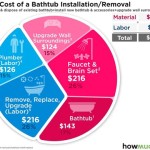Actual Size of Bathtubs: A Comprehensive Guide
Determining the appropriate bathtub size is a crucial aspect of bathroom design and renovation. Factors such as available space, user needs, and desired aesthetic all contribute to the decision-making process. Understanding the standard dimensions and variations in bathtub sizes is essential for selecting a model that effectively balances comfort, functionality, and visual appeal.
Bathtubs are available in a diverse range of sizes and shapes, catering to various preferences and spatial constraints. The "actual size" of a bathtub, however, goes beyond the overall external dimensions. It also considers the internal bathing well, the depth, and the slope of the backrest. This article provides a comprehensive overview of the actual sizes of different types of bathtubs, offering guidance for making informed choices.
Standard Bathtub Dimensions
The most common type of bathtub is the standard rectangular alcove tub. These are typically installed against three walls, creating a contained bathing area. The standard length for an alcove bathtub ranges from 60 inches (5 feet) to 72 inches (6 feet). The standard width is usually 30 inches, although widths of 32 inches are also available. The depth, measured from the drain to the overflow, generally ranges from 14 to 16 inches. These dimensions represent the external measurements; the internal bathing well will naturally be smaller. The internal dimension can vary depending on the thickness of the tub material and the design of the inner walls.
A 60-inch alcove tub is the most prevalent option, particularly in smaller bathrooms. It offers a balance of comfort and space efficiency. Larger individuals or those prioritizing a more spacious bathing experience may opt for a 72-inch tub. The width is a less variable dimension, but even a couple of inches difference can impact the feeling of spaciousness. The depth is a critical factor for soaking tubs, where a deeper well allows for more water immersion.
Beyond the standard alcove configuration, variations exist within the rectangular shape category. Some manufacturers offer shorter alcove tubs, typically around 54 inches, designed for even smaller bathrooms. These often sacrifice bathing comfort for space savings. Conversely, some alcove tubs are designed with a wider bathing well, even while maintaining the standard external dimensions. This can be achieved through thinner tub walls or a more ergonomic internal design.
Freestanding Bathtub Dimensions
Freestanding bathtubs are increasingly popular, adding a touch of elegance and luxury to bathroom designs. Unlike alcove tubs, freestanding models are not attached to any walls, allowing them to be positioned virtually anywhere in the bathroom, provided plumbing connections are available. This flexibility in placement also translates to a wider range of size options.
The length of freestanding bathtubs typically ranges from 55 inches to 75 inches, and even longer in some specialized designs. Widths typically range from 27 inches to 36 inches. The depth is often greater than that of standard alcove tubs, ranging from 18 inches to 24 inches, contributing to a more immersive soaking experience. However, these are overall dimensions. The internal dimensions are affected by the shape – oval, rectangular, slipper, or other unique designs – and the thickness of the material. A thick-walled acrylic tub, for example, may have significantly smaller internal bathing space than a thinner copper or cast iron tub of the same external dimensions.
Slipper bathtubs, a type of freestanding tub, are characterized by a raised backrest, providing a more comfortable reclining position. These often have slightly different dimensions compared to standard freestanding tubs. The raised backrest can impact the overall length, and the internal bathing well is often shaped to accommodate the reclined posture. Double slipper bathtubs, with raised backrests on both ends, are designed for two bathers and tend to be longer and wider than single slipper models.
Consideration should be given to the space surrounding a freestanding tub. Adequate clearance is needed for movement and cleaning. A general guideline is to allow at least 24 inches of clearance around the tub on all sides, but this can be adjusted based on the bathroom's overall layout and traffic patterns.
Corner Bathtub Dimensions
Corner bathtubs, also known as corner soaking tubs or whirlpool tubs, are designed to fit into a corner, maximizing space utilization and creating a focal point in the bathroom. These bathtubs are typically triangular or quadrant-shaped.
The dimensions of corner bathtubs are typically expressed as the length of each side that abuts the wall. Common sizes range from 48 inches by 48 inches to 60 inches by 60 inches. Larger corner tubs can reach sizes of 72 inches by 72 inches or even greater. The depth of corner bathtubs varies, but is generally similar to that of freestanding tubs, ranging from 18 inches to 24 inches. The internal bathing well dimensions are complex due to the shape of the tub. Capacity, measured in gallons, is often a better indicator of the overall bathing space than individual length or width measurements.
Due to their unique shape, corner bathtubs often have a larger footprint than standard alcove tubs. However, they can effectively utilize otherwise unused corner space. The internal bathing well is often more spacious than a standard tub of similar length, due to the wider overall dimensions. This makes them suitable for those who prefer a more expansive bathing area or for couples who want to bathe together. The water capacity can be significant, requiring adequate water heater capacity and floor support.
The shape of corner tubs also impacts the entry and exit. Some corner tubs incorporate a wider entry point for easier access. This is particularly important for individuals with mobility issues. The height of the tub should also be considered, as a lower tub height can simplify entry and exit.
Beyond these primary bathtub types, specialized bathtubs exist, including walk-in tubs and Japanese soaking tubs (ofuro). Walk-in tubs are designed for individuals with limited mobility, featuring a watertight door that allows for easy entry and exit. Japanese soaking tubs are characterized by their tall, narrow design, allowing bathers to sit upright and immerse themselves up to their shoulders. The dimensions of these tubs vary greatly, depending on the specific design and features. Walk-in tubs often prioritize accessibility over spaciousness, while Japanese soaking tubs prioritize depth and compactness.
When determining the actual size of a bathtub, several factors beyond the external dimensions should be considered. The internal bathing well, the depth, the slope of the backrest, and the presence of features such as armrests or jets all contribute to the overall bathing experience. It is crucial to physically examine the bathtub, if possible, or to carefully review product specifications and customer reviews to gain a clear understanding of the actual usable space.
Furthermore, the material of the bathtub can impact its dimensions. Acrylic tubs, for example, may have thicker walls than cast iron or steel tubs, reducing the internal bathing space for the same external dimensions. The shape of the tub also plays a significant role. A tub with contoured sides or a sculpted interior will have a different internal volume than a tub with straight, vertical sides.
Plumbing considerations are also essential when selecting a bathtub size. The location of the drain and overflow should be carefully considered, as these can impact the installation process and the overall aesthetic of the bathroom. Ensure compliance with local plumbing codes and regulations regarding drain size and venting requirements.
Finally, the aesthetic impact of the bathtub on the overall bathroom design should not be overlooked. The size and shape of the bathtub should complement the other fixtures and features in the bathroom, creating a cohesive and visually appealing space. Consider the color, finish, and style of the bathtub, and how these elements interact with the existing décor.

Standard Bathtub Sizes 2024 Guide Modernize

Standard Bathtub Sizes 2024 Guide Modernize

Inster 59 In Modern Acrylic Flatbottom Freestanding Luxury Tub Curve Edge Soaking Non Whirlpool Bathtub White Wshdrmmk0053 The Home Depot

Inster Valley 59 In White Acrylic Oval Freestanding Bowl Shaped Flatbottom Soaking Tub Non Whirlpool Bathtub Wshdrmafl0018 The Home Depot

Tub Size Chart Examples Baths Of Distinction

Tub Replacement Cost In 2024 Forbes Home

How Many Gallons Does A Bathtub Hold Photos Examples 2024

Hydra Massage Baths Designer 60 In X Bone Acrylic Corner Drop Whirlpool Tub Reversible Drain The Bathtubs Department At Com

Inster Loop 59 In White Acrylic Flatbottom Oval Freestanding Soaking Non Whirlpool Bathtub Wshdrmmk0045 The Home Depot

What Is The Average Bathroom Size For Standard And Master
Related Posts








